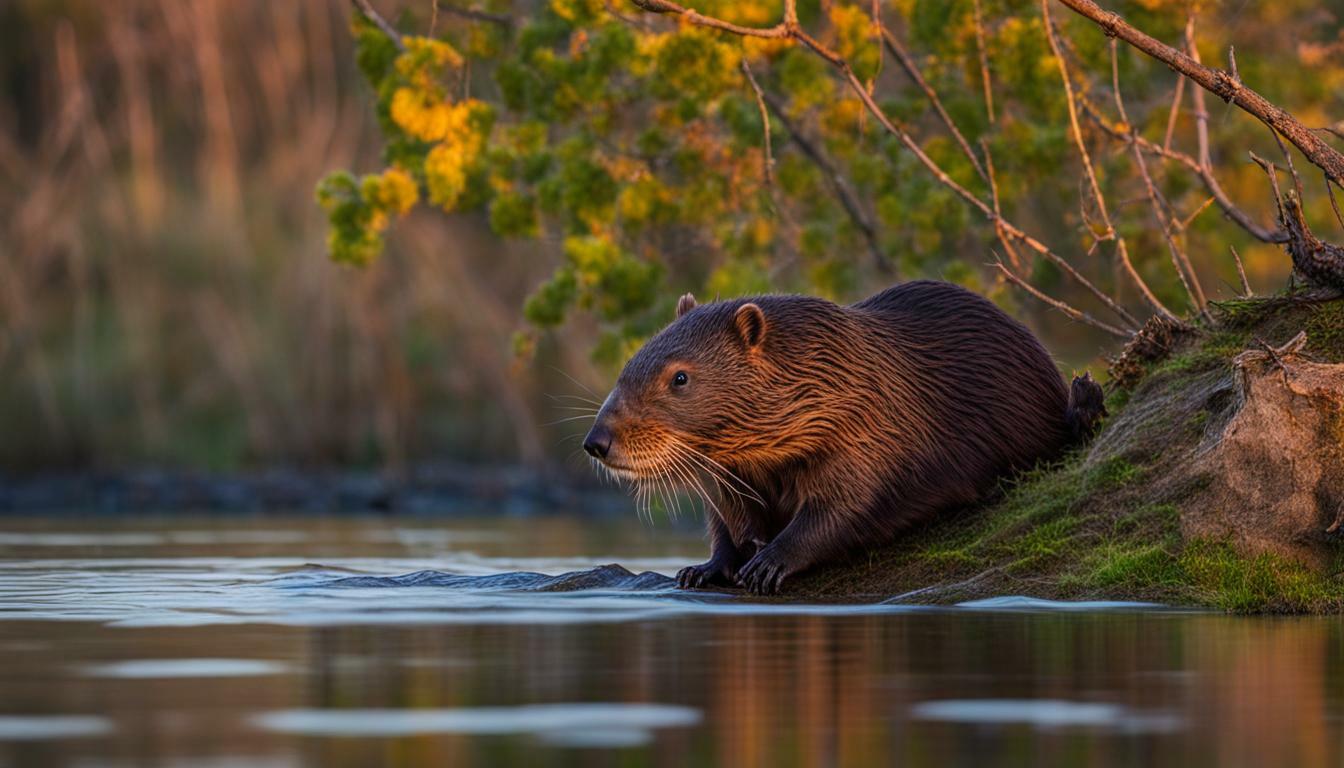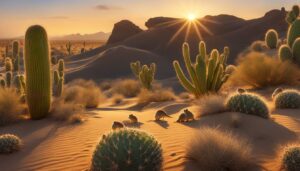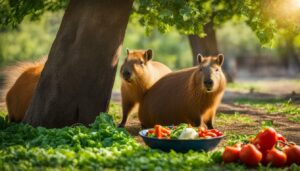Beavers are fascinating creatures known for their unique activity patterns, and understanding when they are most active can offer valuable insights into their lives.
While they are primarily nocturnal animals, beavers can also be active during the day. The optimal time to observe them is at dusk, about an hour before darkness, or at sunrise early in the morning.
During these periods, you are more likely to witness their bustling activity as they go about their daily routines.
Key Takeaways
- Beavers are primarily nocturnal but can also be active during the day.
- The best time to observe beavers is at dusk or sunrise.
- They are most active in the late fall when engaging in intense harvesting.
- Beavers create their own habitats by impounding water.
- They are considered a keystone species, greatly impacting other wildlife by providing quality wetland habitat.
The Natural Rhythm of Beaver Activity
Beavers have a distinct activity cycle that follows a natural rhythm, influenced by both the time of day and the changing seasons.
Understanding this rhythm is key to gaining insight into their behavior and observing them in their natural habitat.
Whether you’re an avid nature enthusiast or simply curious about these fascinating creatures, let’s dive into the intricacies of the beaver activity cycle.
At the core of the beaver activity cycle is their nocturnal nature. While beavers are primarily active during the night, they can also be seen during the day, particularly during the autumn and spring months.
But when are they most active? The best time to observe beavers is at dusk, about an hour before darkness settles in, or at sunrise early in the morning.
During these transitional periods, beavers are more likely to emerge from their lodges and engage in various activities, such as foraging or maintaining their dam structures.
The changing seasons also play a significant role in the natural rhythm of beaver activity. In the late fall, beavers enter a phase of heightened activity as they prepare for the approaching winter.
This is the time when they engage in intense harvesting, gathering food and repairing their dams and lodges.
By reinforcing their structures, beavers ensure a secure and cozy shelter during the colder months.
| Season | Activity |
|---|---|
| Spring | Building dams, repairing lodges, and foraging |
| Summer | Continued maintenance, grooming, and feeding on aquatic vegetation |
| Fall | Intense harvesting, repairing dams and lodges |
| Winter | Conserving energy in their lodges |
Beavers, with their remarkable ability to modify their environment, create their own habitat by impounding water.
Their dams and lodges create wetland ecosystems that support a multitude of species. Considered a keystone species, beavers have a significant impact on other wildlife by providing quality wetland habitat.
Their activity cycle and behavior contribute to the thriving biodiversity of these ecosystems, making them an essential part of the natural world.
Peak Beaver Activity Times
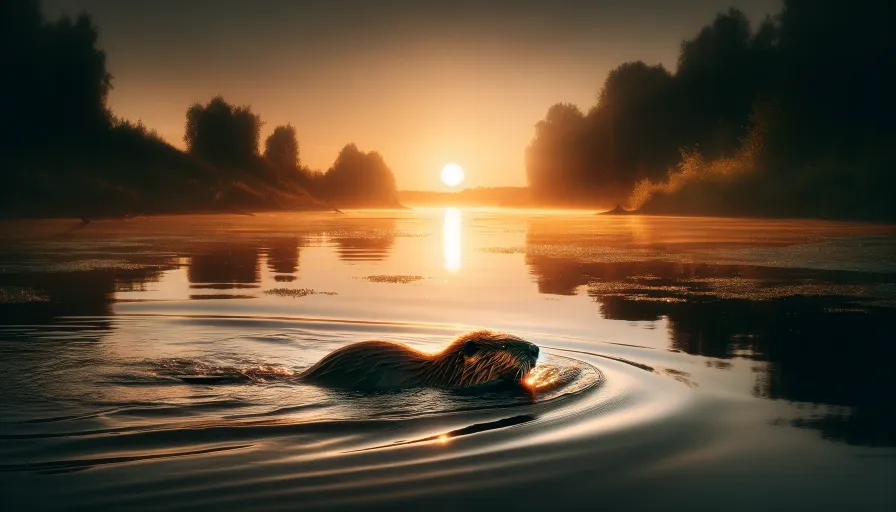
If you want to catch a glimpse of beavers in action, knowing their peak activity times can greatly increase your chances of an exciting encounter.
While beavers are primarily nocturnal animals, they can also be active during the day. However, the best time to observe them is typically at dusk, about an hour before darkness, or at sunrise early in the morning.
During these periods, beavers are more likely to be out and about, engaging in their various activities.
In the late fall, beavers are particularly busy as they prepare for the winter months. This is when they engage in intense harvesting, repairing and building up their dams and lodges.
It is during this time that they gather and store food for the upcoming colder season. So, if you’re looking to witness some fascinating beaver behavior, the late fall is the busiest time for these industrious creatures.
Beavers are known for their remarkable ability to create their own habitat. By impounding water and building dams, they create quality wetland habitats that benefit numerous other species.
As a keystone species, their presence greatly impacts the ecosystem, providing homes for various aquatic creatures, birds, and mammals.
So, observing beavers during their peak activity times not only allows you to witness their fascinating behavior but also provides you with an opportunity to appreciate their crucial role in maintaining the balance of nature.
| Key Points | Key Details |
|---|---|
| Optimal Observation Times | Dusk and dawn are the best times to observe beavers, about an hour before darkness or at sunrise. |
| Busiest Time for Beavers | The late fall is when beavers are most active, engaging in intense harvesting and preparing for winter. |
| Impact as Keystone Species | Beavers play a crucial role in creating quality wetland habitats, benefiting other wildlife. |
Beaver Behavior During Different Seasons
Beavers exhibit different behaviors in response to the challenges and opportunities presented by each season.
As the seasons change, so do the activities of these fascinating creatures. Let’s explore how their behavior varies throughout the year.
In the spring, beavers focus on reproduction and building their lodges. This is an important time for them to establish their territories and construct safe and comfortable homes.
They also gather fresh vegetation to replenish their food supplies after the long winter months.
During the summer, beavers continue to maintain their lodges and dams, ensuring they remain intact and well-functioning.
They spend a significant amount of time foraging for food, feasting on a variety of plants, aquatic vegetation, and bark.
The warm weather provides optimal conditions for their activities, as they can freely navigate through the waterways.
As we move into the fall season, beavers become especially active. This is when they engage in intense harvesting, cutting down trees and collecting branches to store as food for the winter.
They also focus on repairing and building up their dams and lodges, preparing for the colder months ahead.
When winter arrives, beavers become less active. They spend more time inside their lodges, conserving energy and relying on their food stores.
Their movements are minimized, allowing them to survive the freezing temperatures and limited food availability.
By understanding how beavers adapt to the changing seasons, we can better appreciate their remarkable abilities and the important role they play in shaping their environment.
From building dams and lodges to providing vital wetland habitats, beavers truly are fascinating creatures that deserve our admiration.
Dusk and Dawn: Ideal Observation Times
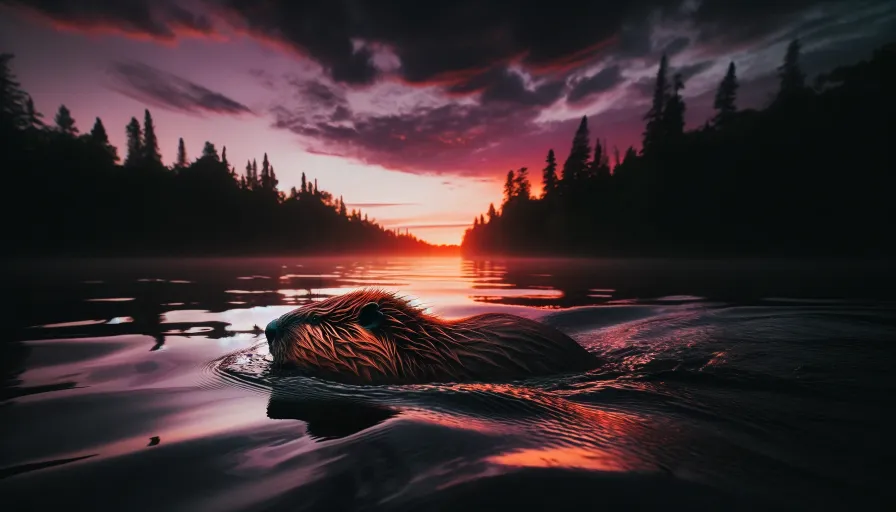
To catch beavers in their element, plan your observations during the magical hours of dusk and dawn.
These times of day offer the best opportunity to witness their fascinating behavior and understand their activity patterns.
Beavers are primarily nocturnal animals, but they can also be active during the day. However, it is during the transition from light to darkness, and vice versa, that they truly shine.
At dusk, about an hour before darkness, beavers emerge from their lodges to forage for food, repair dams, and carry out other essential tasks.
The soft glow of the setting sun creates a captivating backdrop as you observe their industrious nature.
Similarly, at sunrise early in the morning, beavers are once again on the move, busily preparing for the day ahead.
The peaceful stillness of the morning light combined with the gentle sounds of nature make for a truly immersive experience.
Whether you’re near a river, lake, or wetland, these serene moments at dawn provide an ideal opportunity to witness beavers in action.
Keep in mind that while dusk and dawn offer the best chances for observing beavers, they can be active at other times as well.
So, don’t hesitate to explore their habitat throughout the day, but remember that the magic truly happens when the world is transitioning between light and dark.
Table: Beaver Activity Times
| Time | Activity |
|---|---|
| Dusk | Emerging from lodges, foraging, dam repairs |
| Dawn | Preparing for the day, gathering food |
Beavers as Nocturnal Animals
While beavers can be active during the day, they primarily operate under the cover of darkness as nocturnal animals.
This means that their activity patterns are most pronounced during the nighttime hours, when they venture out to search for food, build dams, and maintain their lodges.
However, it is important to note that beavers can also exhibit some daytime activity, especially during dusk and dawn.
Observing beavers in their natural habitat during their nocturnal activities can be a truly fascinating experience.
The best time to catch a glimpse of these industrious creatures is at dusk, about an hour before darkness sets in, or at sunrise early in the morning.
These periods offer optimal lighting conditions for watching their behaviors without disturbing their natural routines.
In the late fall, beavers undergo a period of intense activity known as the harvesting season. During this time, they work diligently to gather food for the upcoming winter months, repairing and building up their dams and lodges.
The fall season is a particularly busy time for beavers, providing an excellent opportunity to witness their frenzy of activity as they prepare for the colder weather.
By impounding water and constructing intricate structures, beavers create their own habitat, making them an important keystone species.
Their ability to manipulate their environment has a profound impact on the ecosystem, especially by providing quality wetland habitats for numerous other species.
This unique characteristic sets beavers apart, showcasing their remarkable role in shaping the natural world around them.
Table: Beaver Activity Patterns
| Time | Activity |
|---|---|
| Dusk | Increased activity as beavers prepare for the night ahead |
| Throughout the night | Active period for foraging, building, and maintenance tasks |
| Dawn | Continued activity as beavers wind down after a night of work |
The Fall Harvesting Season
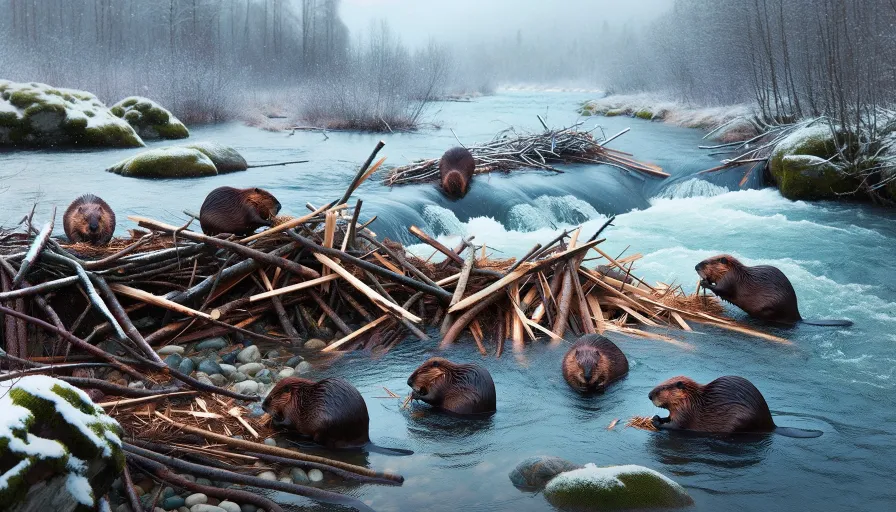
As the days grow shorter and temperatures drop, beavers enter a period of increased activity, known as the fall harvesting season.
During this time, beavers engage in intense work to prepare for the upcoming winter. They are busy repairing and building up their dams and lodges, ensuring that they have a sturdy structure to withstand the harsh conditions.
Beavers are well-known for their ability to create their own habitat by impounding water. This unique behavior has a significant impact on other wildlife, making them a keystone species.
By creating and maintaining wetland habitats, beavers provide a valuable environment for many species to flourish.
The fall harvesting season is an important time for beavers as they gather and store food for the winter months.
They cut down trees and haul them to their lodges, building up a stockpile of branches and logs. This resourcefulness ensures that they have enough food to sustain themselves during the colder season when foraging opportunities may be limited.
Observing beavers during the fall harvesting season can be a fascinating experience. Their increased activity and dedication to their work are remarkable to witness.
If you’re planning to observe beavers, the best time to do so is at dusk, about an hour before darkness, or at sunrise early in the morning.
These times offer ideal conditions for spotting these industrious creatures as they go about their tasks.
| Key Points | |
|---|---|
| Beavers enter a period of increased activity during the fall harvesting season. | |
| They repair and build up their dams and lodges to prepare for winter. | |
| Beavers are considered a keystone species that significantly impact other wildlife by creating wetland habitats. | |
| They gather and store food, cutting down trees and stockpiling branches and logs. | |
| The best time to observe beavers is at dusk or at sunrise. |
Beaver Impact as Keystone Species
Beavers play a vital role in shaping ecosystems, with their activity patterns influencing the habitats of numerous other species.
Their behavior during different seasons has a significant impact on the surrounding environment. In the late fall, beavers become particularly active as they prepare for the winter months.
This is a crucial time for them, as they engage in intense harvesting activities to repair and build up their dams and lodges.
Not only do beavers construct their own habitat by impounding water, but they also create quality wetland habitats that benefit a wide range of other wildlife.
Their ability to create dams and lodges alters the landscape, leading to the formation of ponds and wetlands.
These wetland ecosystems support a diverse array of plant and animal species, making them important breeding and feeding grounds.
As a keystone species, beavers have a profound influence on the dynamics of the ecosystems they inhabit.
Their alteration of water flow and landscape structure promotes biodiversity by providing suitable habitats for many species.
Wetlands created by beavers act as natural water filters, improving water quality and reducing erosion.
They also contribute to carbon storage and assist in controlling flooding by regulating water levels in their habitats.
| Beaver Impact as Keystone Species | |
|---|---|
| Creates wetland habitats | Supports diverse plant and animal species |
| Alters landscape structure | Promotes biodiversity |
| Improves water quality | Reduces erosion |
| Contributes to carbon storage | Controls flooding |
Understanding the activity patterns of beavers and their role as a keystone species is crucial for conservation efforts.
By appreciating their impact on ecosystems, we can work towards preserving their habitats and ensuring the survival of not only beavers but also the many species that rely on them.
Beavers are renowned for their ability to build impressive dams and lodges, which form an integral part of their activity patterns.
These structures serve as both protective shelters and water impoundments, allowing beavers to create and control their own habitats.
By manipulating water levels, they can build and maintain complex systems that benefit not only themselves but also other wildlife in the area.
Building dams is a crucial behavior for beavers, as it helps create deep ponds or wetlands. These water impoundments provide a safe environment for beavers to live and raise their young.
Dams also serve as a defense mechanism, protecting them from predators and reducing the risk of threats.
Beavers construct their lodges within these ponds or wetlands. These lodges are built with sticks, mud, and other natural materials, providing secure living spaces above the water level.
The entrances to the lodges are usually located underwater, allowing beavers to access their dwellings safely.
Beavers are truly remarkable architects of their own ecosystems. Through their dam-building and lodge-construction activities, they influence the water flow, promote biodiversity, and create vital wetland habitats for numerous species to thrive.
Understanding these beaver activity patterns allows us to appreciate their significant role as a keystone species in shaping and maintaining our natural environment.
In conclusion, beavers’ ability to build dams and lodges is a key aspect of their activity patterns. These structures not only serve as protective shelters and water impoundments but also contribute to the creation of quality wetland habitats.
By observing and understanding beavers’ behavior and habitat-building techniques, we can gain a deeper appreciation for these fascinating creatures and the ecological impact they have on the environment.
Observing and Appreciating Beavers
Observing and appreciating beavers can be a rewarding experience if done with awareness and respect for their natural rhythms.
These fascinating creatures are primarily nocturnal, meaning they are most active during the night.
However, they can also be seen during the day, especially around dusk and at sunrise. These twilight hours, about an hour before darkness and early in the morning, provide the optimal time to witness their activity.
When observing beavers, it’s important to remember that they are skilled architects of their own habitat.
They create intricate dams and lodges to impound water, shaping the environment around them. Beavers are considered a keystone species, meaning their presence has a significant impact on the ecosystem.
By providing quality wetland habitat, they support a diverse range of wildlife.
If you’re lucky enough to witness beavers in action, take the time to appreciate their diligent work and resourcefulness.
Notice the way they meticulously repair and build up their dams and lodges, especially during the late fall when they engage in intense harvesting.
These activities serve as their preparation for the upcoming winter months, ensuring their survival in harsh conditions.
| Tips for observing and appreciating beavers: |
|---|
| 1. Find a suitable location: Look for areas with bodies of water, such as rivers, lakes, or ponds, where beavers are known to inhabit. |
| 2. Be patient and quiet: Beavers are sensitive to noise and disturbances, so maintain a calm and quiet demeanor to avoid startling or scaring them away. |
| 3. Bring binoculars: Beavers may be active near the water’s edge or in the middle of a pond, so having binoculars can enhance your viewing experience. |
| 4. Observe from a safe distance: It’s important to keep a respectful distance from beavers and not to disturb their natural behavior or habitat. |
| 5. Respect their habitat: Avoid leaving any traces of your visit, such as litter or damage to vegetation. Leave the area as you found it to preserve the beavers’ habitat. |
By following these tips and being mindful of their natural rhythms, you can have a meaningful and fulfilling experience observing and appreciating beavers.
Remember, these remarkable creatures contribute to the biodiversity of our ecosystems, and by respecting their habitat, we can ensure their continued presence for future generations to enjoy.
Conclusion
By unraveling the mysteries of beaver activity patterns, we gain a deeper appreciation for these remarkable creatures and their role in shaping the natural world.
Beavers are primarily nocturnal animals, but they can also be active during the day. The best time to observe beavers is at dusk, about an hour before darkness, or at sunrise early in the morning.
During the late fall, beavers are most active as they engage in intense harvesting activities. This is their preparation for winter, as they repair and build up their dams and lodges.
Their ability to create their own habitat by impounding water showcases their remarkable engineering skills.
In addition to their impressive construction abilities, beavers are considered a keystone species. Their actions greatly impact other wildlife by providing quality wetland habitat for many species.
These wetlands are vital ecosystems that support a diverse range of flora and fauna, making the beavers’ influence truly significant.
Next time you venture into the great outdoors, keep an eye out for these industrious and fascinating creatures.
Whether they are busy building dams, repairing lodges, or simply exploring their surroundings, observing beavers in their natural habitat is truly a delightful experience.
Just remember to approach with respect, ensuring minimal disturbance to their environment, and you’ll have a memorable encounter with these impressive creatures.
FAQ
When are beavers most active?
Beavers are primarily nocturnal animals, but they can also be active during the day. The best time to observe beavers is at dusk, about an hour before darkness, or at sunrise early in the morning.
When are beavers most active during the year?
Beavers are most active in the late fall when they engage in intense harvesting, as they prepare for winter by repairing and building up dams and lodges.
Why are beavers considered a keystone species?
Beavers are considered a keystone species because they greatly impact other wildlife by providing quality wetland habitat for many species.
What is the significance of beavers impounding water?
Beavers have the ability to create their own habitat by impounding water, which helps them in constructing dams and lodges and creating suitable wetland environments.
What are the ideal observation times for beavers?
The ideal observation times for beavers are at dusk, about an hour before darkness, or at sunrise early in the morning.
Are beavers mainly active during the night?
Beavers are primarily nocturnal animals, but they can also be active during the day.
What is the significance of fall season for beavers?
Beavers are most active during the fall season when they engage in intense harvesting activities, preparing for winter by repairing and building up dams and lodges.
How do beavers impact other wildlife as a keystone species?
Beavers impact other wildlife as a keystone species by providing quality wetland habitat that benefits many different species.
What is the behavior of beavers during different seasons?
The behavior of beavers varies throughout the different seasons as they adapt to survive and thrive in changing environmental conditions.
What do beavers build besides dams and lodges?
Beavers also build lodges, which serve as their homes and provide protection from predators and harsh weather conditions.
What are some interesting facts about beavers?
Beavers are fascinating creatures known for their ability to create their own habitat, build dams and lodges, and impact other wildlife as a keystone species.
How can I observe and appreciate beavers?
To observe and appreciate beavers, it is best to visit their habitats during the optimal observation times of dusk or dawn. Remember to respect their natural environment and keep a safe distance.

